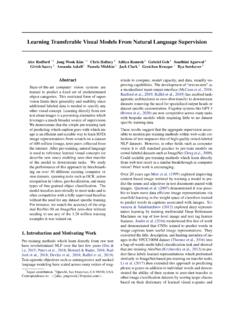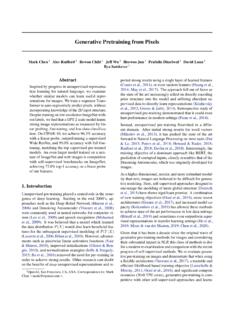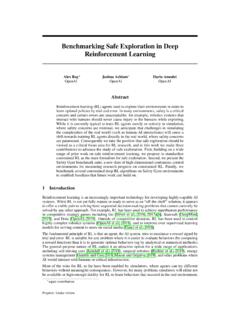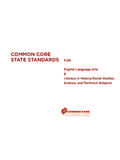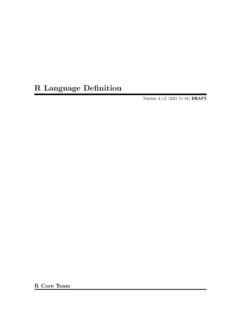Transcription of Training language models to follow instructions with human ...
1 Training language models to follow instructionswith human feedbackLong Ouyang Jeff Wu Xu Jiang Diogo Almeida Carroll L. Wainwright Pamela Mishkin Chong ZhangSandhini AgarwalKatarina SlamaAlex RayJohn SchulmanJacob HiltonFraser KeltonLuke MillerMaddie SimensAmanda Askell Peter WelinderPaul Christiano Jan Leike Ryan Lowe OpenAIAbstractMaking language models bigger does not inherently make them better at followinga user s intent. For example, large language models can generate outputs thatare untruthful, toxic, or simply not helpful to the user. In other words, thesemodels are notalignedwith their users. In this paper, we show an avenue foraligning language models with user intent on a wide range of tasks by fine-tuningwith human feedback. Starting with a set of labeler-written prompts and promptssubmitted through the OpenAI API, we collect a dataset of labeler demonstrationsof the desired model behavior, which we use to fine-tune GPT-3 using supervisedlearning.
2 We then collect a dataset of rankings of model outputs, which we use tofurther fine-tune this supervised model using reinforcement learning from humanfeedback (RLHF). We call the resulting modelsInstructGPT. In human evaluationson our prompt distribution, outputs from the parameter InstructGPT model arepreferred to outputs from the 175B GPT-3, despite having 100x fewer , InstructGPT models show improvements in truthfulness and reductionsin toxic output generation while having minimal performance regressions on publicNLP datasets. Even though InstructGPT still makes simple mistakes, our resultsshow that fine-tuning with human feedback is a promising direction for aligninglanguage models with human IntroductionLarge language models (LMs) can be prompted to perform a range of natural language process-ing (NLP) tasks, given some examples of the task as input.
3 However, these models often expressunintended behaviors such as making up facts, generating biased or toxic text, or simply not followinguser instructions (Bender et al., 2021; Bommasani et al., 2021; Kenton et al., 2021; Weidinger et al.,2021; Tamkin et al., 2021; Gehman et al., 2020). This is because the language modeling objective Primary authors. This was a joint project of the OpenAI Alignment team. RL and JL are the team Work done while at OpenAI. Current affiliations: AA: Anthropic; PC: Alignment Research rate against SFT 175 BModelPPO-ptxPPOSFTGPT (prompted)GPTF igure 1: human evaluations of various models on our API prompt distribution, evaluated by howoften outputs from each model were preferred to those from the 175B SFT model . Our InstructGPTmodels (PPO-ptx) as well as its variant trained without pretraining mix (PPO) significantly outperformthe GPT-3 baselines (GPT, GPT prompted); outputs from our PPO-ptx model are preferred tothose from the 175B GPT-3.
4 Error bars throughout the paper are 95% confidence for many recent large LMs predicting the next token on a webpage from the internet isdifferent from the objective follow the user s instructions helpfully and safely (Radford et al., 2019;Brown et al., 2020; Fedus et al., 2021; Rae et al., 2021; Thoppilan et al., 2022). Thus, we say thatthe language modeling objective ismisaligned. Averting these unintended behaviors is especiallyimportant for language models that are deployed and used in hundreds of make progress on aligning language models by Training them to act in accordance with the user sintention (Leike et al., 2018). This encompasses both explicit intentions such as following instructionsand implicit intentions such as staying truthful, and not being biased, toxic, or otherwise the language of Askell et al. (2021), we want language models to behelpful(they shouldhelp the user solve their task),honest(they shouldn t fabricate information or mislead the user), andharmless(they should not cause physical, psychological, or social harm to people or the environment).
5 We elaborate on the evaluation of these criteria in Section focus onfine-tuningapproaches to aligning language models . Specifically, we use reinforcementlearning from human feedback (RLHF; Christiano et al., 2017; Stiennon et al., 2020) to fine-tuneGPT-3 to follow a broad class of written instructions (see Figure 2). This technique uses humanpreferences as a reward signal to fine-tune our models . We first hire a team of 40 contractors to labelour data, based on their performance on a screening test (see Section and Appendix for moredetails). We then collect a dataset of human -written demonstrations of the desired output behavioron (mostly English) prompts submitted to the OpenAI API3and some labeler-written prompts, anduse this to train our supervised learning baselines. Next, we collect a dataset of human -labeledcomparisons between outputs from our models on a larger set of API prompts.
6 We then train a rewardmodel (RM) on this dataset to predict which model output our labelers would prefer. Finally, weuse this RM as a reward function and fine-tune our supervised learning baseline to maximize thisreward using the PPO algorithm (Schulman et al., 2017). We illustrate this process in Figure 2. Thisprocedure aligns the behavior of GPT-3 to the stated preferences of a specific group of people (mostlyour labelers and researchers), rather than any broader notion of human values ; we discuss thisfurther in Section We call the resulting mainly evaluate our models by having our labelers rate the quality of model outputs on our testset, consisting of prompts from held-out customers (who are not represented in the Training data).We also conduct automatic evaluations on a range of public NLP datasets. We train three model3 Specifically, we train on prompts submitted to earlier versions of the InstructGPT models on the OpenAIAPI Playground, which were trained only using demonstration data.
7 We filter out prompts containing 2: A diagram illustrating the three steps of our method: (1) supervised fine-tuning (SFT), (2)reward model (RM) Training , and (3) reinforcement learning via proximal policy optimization (PPO)on this reward model . Blue arrows indicate that this data is used to train one of our models . In Step 2,boxes A-D are samples from our models that get ranked by labelers. See Section 3 for more detailson our ( , 6B, and 175B parameters), and all of our models use the GPT-3 architecture. Our mainfindings are as follows:Labelers significantly prefer InstructGPT outputs over outputs from our test set,outputs from the parameter InstructGPT model are preferred to outputs from the 175B GPT-3,despite having over 100x fewer parameters. These models have the same architecture, and differ onlyby the fact that InstructGPT is fine-tuned on our human data.
8 This result holds true even when weadd a few-shot prompt to GPT-3 to make it better at following instructions . Outputs from our 175 BInstructGPT are preferred to 175B GPT-3 outputs 85 3% of the time, and preferred 71 4% of thetime to few-shot 175B GPT-3. InstructGPT models also generate more appropriate outputs accordingto our labelers, and more reliably follow explicit constraints in the models show improvements in truthfulness over the TruthfulQAbenchmark, InstructGPT generates truthful and informative answers about twice as often as results are equally strong on the subset of questions that were not adversarially selected againstGPT-3. On closed-domain tasks from our API prompt distribution, where the output should notcontain information that is not present in the input ( summarization and closed-domain QA),InstructGPT models make up information not present in the input about half as often as GPT-3 (a21% vs.)
9 41% hallucination rate, respectively).InstructGPT shows small improvements in toxicity over GPT-3, but not measuretoxicity, we use the RealToxicityPrompts dataset (Gehman et al., 2020) and conduct both automaticand human evaluations. InstructGPT models generate about 25% fewer toxic outputs than GPT-3when prompted to be respectful. InstructGPT does not significantly improve over GPT-3 on theWinogender (Rudinger et al., 2018) and CrowSPairs (Nangia et al., 2020) can minimize performance regressions on public NLP datasets by modifying our RLHF fine-tuning RLHF fine-tuning, we observe performance regressions comparedto GPT-3 on certain public NLP datasets, notably SQuAD (Rajpurkar et al., 2018), DROP (Dua et al.,2019), HellaSwag (Zellers et al., 2019), and WMT 2015 French to English translation (Bojar et al.,2015). This is an example of an alignment tax since our alignment procedure comes at the cost of3lower performance on certain tasks that we may care about.
10 We can greatly reduce the performanceregressions on these datasets by mixing PPO updates with updates that increase the log likelihood ofthe pretraining distribution (PPO-ptx), without compromising labeler preference models generalize to the preferences of held-out labelers that did not produce anytraining test the generalization of our models , we conduct a preliminary experiment withheld-out labelers, and find that they prefer InstructGPT outputs to outputs from GPT-3 at about thesame rate as our Training labelers. However, more work is needed to study how these models performon broader groups of users, and how they perform on inputs where humans disagree about the NLP datasets are not reflective of how our language models are compare GPT-3 fine-tuned on our human preference data ( InstructGPT) to GPT-3 fine-tuned on two differentcompilations of public NLP tasks: the FLAN (Wei et al.)
